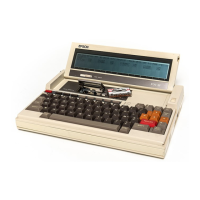REV.-A
2.11 .2.6
Reception
The input interface line signals
RXD,
CTS,
DSR,
and
CD
can always be read, regardless
of
whether
power
is on
or
off.
That is, the RS-232C interface supply voltage regulator needs
not
be turned on
only
for
reception
provided
that
the
CD
(DCD) signal is monitored
with
the
DSR
signal held high
or
the reception
check is disabled .
• The
10
kohm current
limiting
resistor insert-
ed
on the receive signal line
as
shown
in Fig.
2-110
protects the connected device from
excess current
or
voltage drop. The next vol-
tage
limiter
circuit, consisting
of
two
diodes,
and converts the RS-232C line levels from
the mating
transmitter
to
the
0/+5V
TTL le-
vels. The
100
kohm resistor pulls the limiter
output
down
to
ensure
that
the inverter
IC
98
to
functions properly.
2.11.2.7
Operation
Mode
Switching
The transmit/receive lines between the option
unit (if connected) are connected
to
the trans-
mit/receive data lines (TXD/RXD) between the
serial controller 82C51 (2A),
as
well
as
to
the
those lines going
to
and
from
the RS-232C in-
terface,
as
shown
in Fig.
2-111.
These
two
pairs
of
lines cannot
be
controlled
simultaneously.
It
is necessary
to
enable one
either pair
or
no
other. This is accomplished by
the
AUX
signal, issued
from
gate array
GAH40M. This signal is controlled by the main
CPU
using
bit
5
of
its I/O address
0002.
When
the
bit
is 0, the
AUX
signal is held low, disa-
bling the transmit/receive data lines
to/from
the RS-232C interface at gates 3E and 12C re-
spectively.
When
the
bit
is 1;
i.e.,
the
AUX
sig-
nal is high, the data lines are disabled. Thus,
the option unit data lines
must
be
disabled at
the option unit in order
to
prevent mixture
of
the signals.
2-107
9
RXD
Current
limiting
resistor
Fig.
2-110
82C51 (2A)
TXD
.-----;l..-T
x 0
R36
GAH40M
~------~~-----oAUX
TXD
~------~~---~
RS-232C:
interface
Fig.2-111
Option
unit

